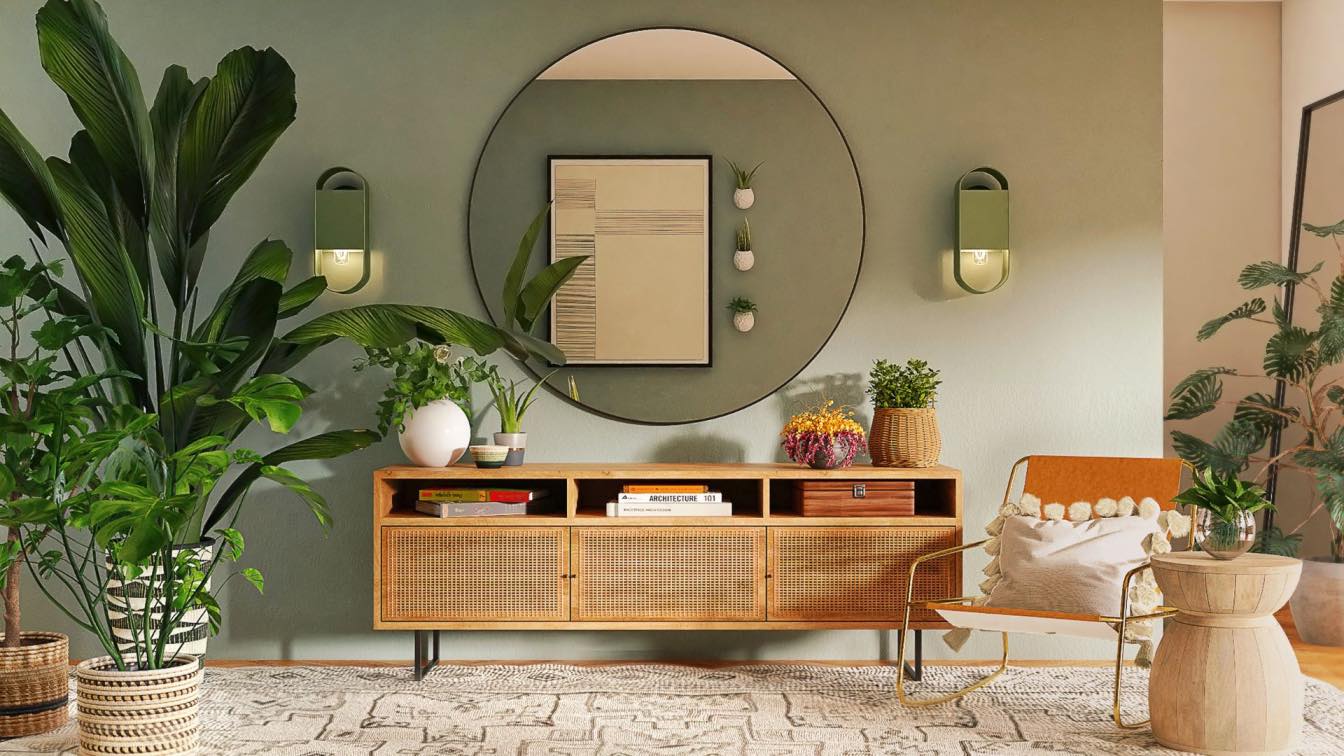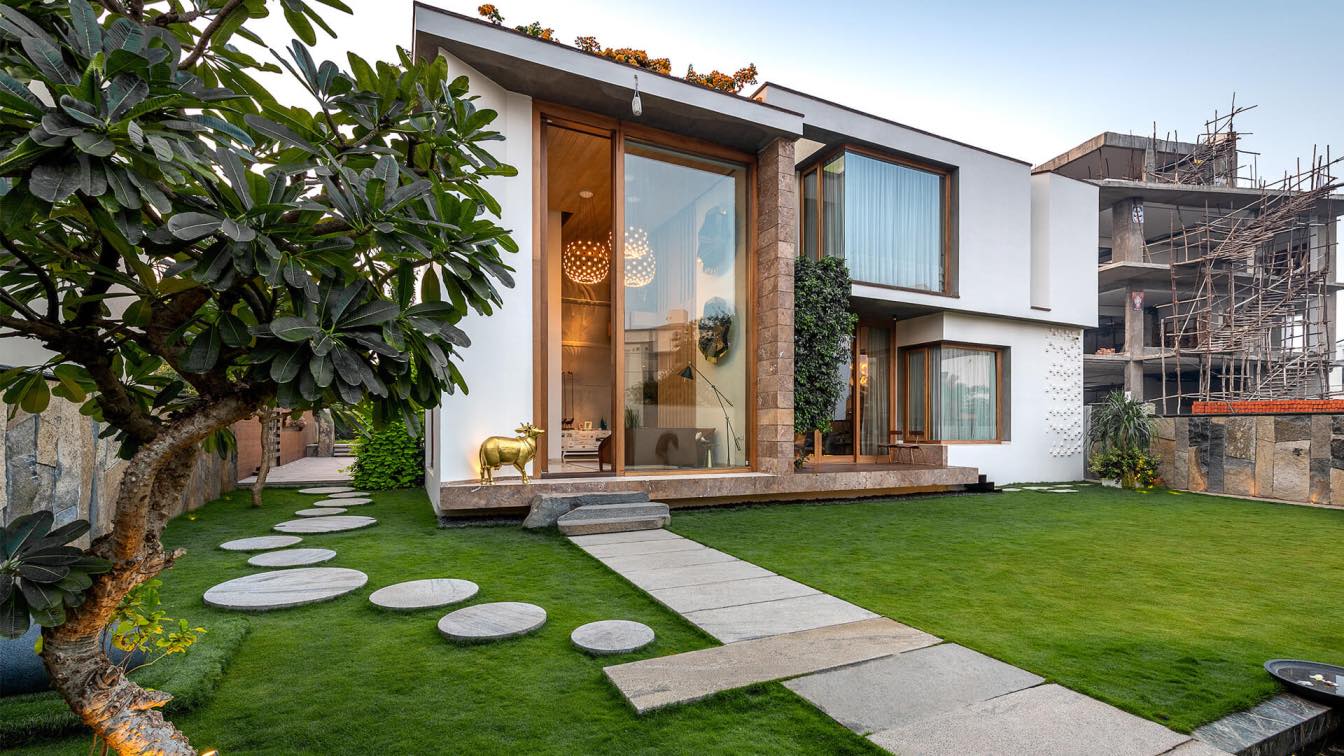To add a touch of beauty to an indoor space, a strategically placed house plant can achieve remarkable results. Not only do they add aesthetic appeal, but they also improve air quality, reduce stress, and create a calming environment. Today we will explore the world of green architecture, focusing on the species appropriate for diverse climates and how to incorporate them into various architectural designs.
Architectural Accents with Fiddle Leaf Fig
The Fiddle Leaf Fig (Ficus lyrata) is a sought-after choice for architects and interior designers, primarily because of its striking, sculptural leaves and commanding presence. This plant effortlessly infuses sophistication into any space, whether as a standalone centerpiece or nestled among other complementary plants. Its versatility allows it to blend into various design styles, ranging from modern to traditional. Although the Fiddle Leaf Fig is relatively easy to care for, it does require bright, indirect light to flourish. To maintain its health, ensure that you water it judiciously, as excessive moisture can lead to root rot.
Indigenous Beauty with Kangaroo Paw Fern
Showcasing the enchanting charm of Australian flora, the Kangaroo Paw Fern (Microsorum diversifolium) is an indigenous plant that adds a unique, native touch to any indoor space. Its delicate, arching fronds bear a distinctive, paw-like appearance, transforming the fern into an intriguing focal point. The Kangaroo Paw Fern thrives in well-draining soil and appreciates humidity, making it an excellent option for bathrooms or kitchens, where moisture levels tend to be higher.
 image © Andrew Neel
image © Andrew Neel
Striking Silhouettes with Snake Plant
Renowned for its hardiness and low-maintenance nature, the Snake Plant (Sansevieria), also known as Mother-in-Law’s Tongue, is well-suited to a variety of architectural styles. Its long, upright leaves create a captivating silhouette, making it a flawless addition to minimalist, modern, and industrial interiors. Besides its aesthetic appeal, the Snake Plant is also a powerful air purifier, adept at removing toxins such as benzene and formaldehyde from the environment. With its ability to thrive in low light conditions and minimal watering requirements, this resilient plant is the perfect choice for busy individuals seeking to enhance their living spaces. Sydneysiders, for example, can effortlessly incorporate this native beauty into their homes, as several services for plant delivery in Sydney offer the Snake Plant, ready to enhance your interior.
Cascading Charm with String of Pearls
Add a touch of playfulness to your interior design with the enchanting String of Pearls (Senecio rowleyanus). This distinctive succulent features small, spherical leaves that cascade gracefully down its vines, evoking the mesmerizing effect of a waterfall. Its captivating appearance makes it an exceptional choice for hanging planters, shelves, or window ledges, where its trailing vines can be showcased to their full potential. The String of Pearls harmonizes beautifully with other trailing plants, such as the Devil’s Ivy (Epipremnum aureum), creating a lush, cascading ensemble. To keep this succulent healthy, provide bright, indirect light and well-draining soil, and water it sparingly to prevent over-watering.
Structural Splendour with ZZ Plant
The ZZ Plant (Zamioculcas zamiifolia) offers structural splendor for those seeking an architectural plant that demands minimal upkeep. Its glossy, dark green leaves exude a striking appearance, melding boldness, and elegance seamlessly. The ZZ Plant’s adaptability to various light conditions, from bright indirect light to low light, and its ability to tolerate infrequent watering make it an ideal choice for individuals with less-than-perfect green thumbs or busy schedules. This hardy plant is perfect for effortlessly elevating any space.
 image © Scott Webb
image © Scott Webb
Flexible Foliage with Rubber Plant
The Rubber Plant (Ficus elastica) presents a versatile option for those looking to adapt to a broad range of interior styles. Its large, glossy leaves and sturdy trunk make a bold statement in any space, while its various cultivars, such as the popular ‘Burgundy’ variety with deep red leaves, offer even more options for customization. The Rubber Plant is not only a visual delight but also an excellent air purifier, known to remove toxins from the air. To keep this plant thriving, provide bright, indirect light and well-draining soil, and allow the soil to dry out slightly between waterings to prevent root rot.
Airy Ambiance with Boston Fern
Create an airy, lush atmosphere in any indoor space with the timeless Boston Fern (Nephrolepis exaltata). Its delicate, feathery fronds exude elegance, making it a fitting addition to traditional, contemporary, or even bohemian-style interiors. The Boston Fern thrives in high-humidity environments, such as bathrooms or sunrooms with ample indirect light. To maintain its vibrant appearance, regularly mist the fronds and ensure the soil remains consistently moist. This classic choice will bring a touch of nature’s elegance into your home.
 image © Annie Spratt
image © Annie Spratt
Modern Minimalism with Monstera Deliciosa
For those seeking a visually captivating option for modern, minimalist spaces, look no further than the Monstera Deliciosa, also known as the Swiss Cheese Plant. Its unique split leaves create an intriguing visual effect, infusing a touch of tropical flair into any room. As this plant can grow quite large, it serves as a stunning centerpiece in spacious areas, commanding attention and admiration. Monstera Deliciosa prefers bright, indirect light and moderate watering, with the soil allowed to dry out slightly between sessions. This statement plant will effortlessly elevate your minimalist interior design.
Conclusion
Incorporating indoor plants into your architectural spaces is more than just an aesthetic choice; it is an opportunity to create an inviting, dynamic atmosphere that fosters well-being and enhances the quality of life. The harmonious blend of architecture and nature can stimulate creativity, encourage relaxation, and inspire a deeper connection with the natural world. So, as you explore the diverse array of plants available, remember that each one holds the potential to transform your space into a sanctuary that celebrates both form and function while nurturing the soul.





